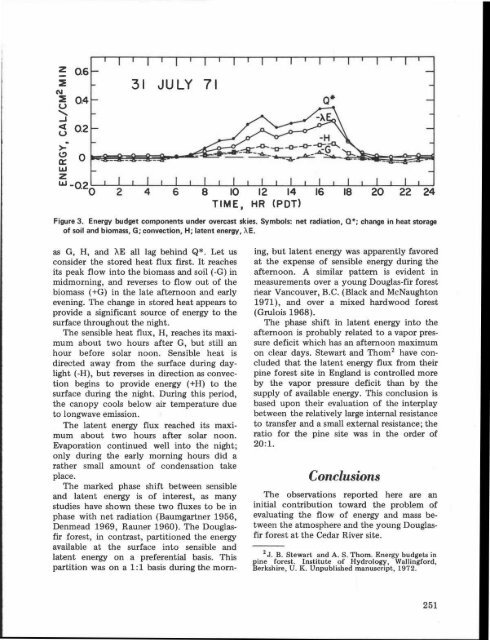PE EIE[R-Rg RESEARCH ON - HJ Andrews Experimental Forest
PE EIE[R-Rg RESEARCH ON - HJ Andrews Experimental Forest
PE EIE[R-Rg RESEARCH ON - HJ Andrews Experimental Forest
Create successful ePaper yourself
Turn your PDF publications into a flip-book with our unique Google optimized e-Paper software.
4 8 10 12 14 16 18 20 22 24<br />
TIME, HR (PDT )<br />
Figure 3 . Energy budget components under overcast skies . Symbols : net radiation, Q* ; change in heat storage<br />
of soil and biomass, G ; convection, H ; latent energy, XE .<br />
as G, H, and XE all lag behind Q* . Let us<br />
consider the stored heat flux first . It reache s<br />
its peak flow into the biomass and soil (-G) i n<br />
midmorning, and reverses to flow out of th e<br />
biomass (+G) in the late afternoon and earl y<br />
evening. The change in stored heat appears t o<br />
provide a significant source of energy to th e<br />
surface throughout the night .<br />
The sensible heat flux, H, reaches its maxi -<br />
mum about two hours after G, but still a n<br />
hour before solar noon . Sensible heat i s<br />
directed away from the surface during day -<br />
light (-H), but reverses in direction as convection<br />
begins to provide energy (+H) to th e<br />
surface during the night . During this period ,<br />
the canopy cools below air temperature du e<br />
to longwave emission .<br />
The latent energy flux reached its maxi -<br />
mum about two hours after solar noon .<br />
Evaporation continued well into the night ;<br />
only during the early morning hours did a<br />
rather small amount of condensation tak e<br />
place .<br />
The marked phase shift between sensible<br />
and latent energy is of interest, as many<br />
studies have shown these two fluxes to be i n<br />
phase with net radiation (Baumgartner 1956 ,<br />
Denmead 1969, Rauner 1960) . The Douglas -<br />
fir forest, in contrast, partitioned the energy<br />
available at the surface into sensible and<br />
latent energy on a preferential basis . This<br />
partition was on a 1 :1 basis during the morning,<br />
but latent energy was apparently favored<br />
at the expense of sensible energy during th e<br />
afternoon . A similar pattern is evident i n<br />
measurements over a young Douglas-fir forest<br />
near Vancouver, B .C. (Black and McNaughto n<br />
1971), and over a mixed hardwood forest<br />
(Grulois 1968) .<br />
The phase shift in latent energy into the<br />
afternoon is probably related to a vapor pressure<br />
deficit which has an afternoon maximu m<br />
on clear days . Stewart and Thom 2 have concluded<br />
that the latent energy flux from thei r<br />
pine forest site in England is controlled more<br />
by the vapor pressure deficit than by th e<br />
supply of available energy . This conclusion is<br />
based upon their evaluation of the interplay<br />
between the relatively large internal resistanc e<br />
to transfer and a small external resistance ; the<br />
ratio for the pine site was in the order o f<br />
20 :1 .<br />
Conclusions<br />
The observations reported here are a n<br />
initial contribution toward the problem of<br />
evaluating the flow of energy and mass between<br />
the atmosphere and the young Douglas -<br />
fir forest at the Cedar River site .<br />
2 J . B. Stewart and A . S. Thom . Energy budgets i n<br />
pine forest. Institute of Hydrology, Wallingford ,<br />
Berkshire, U . K . Unpublished manuscript, 1972 .<br />
251








